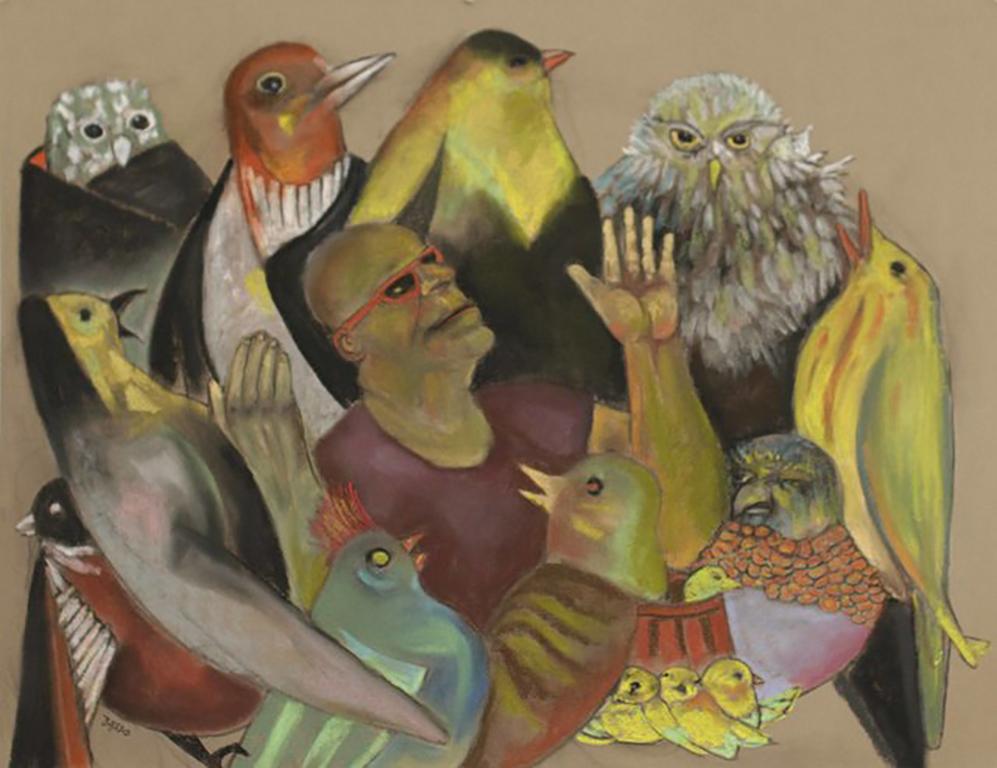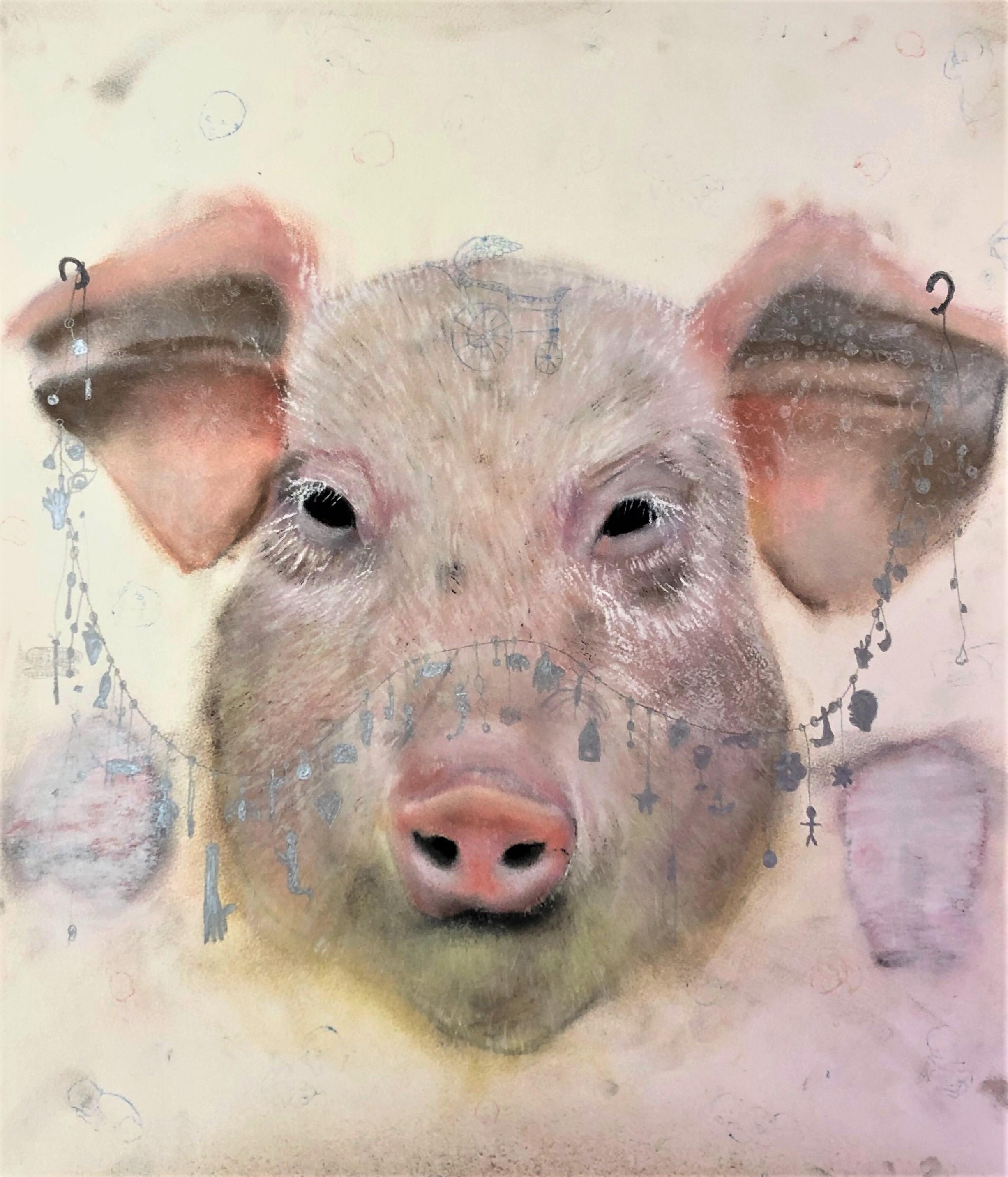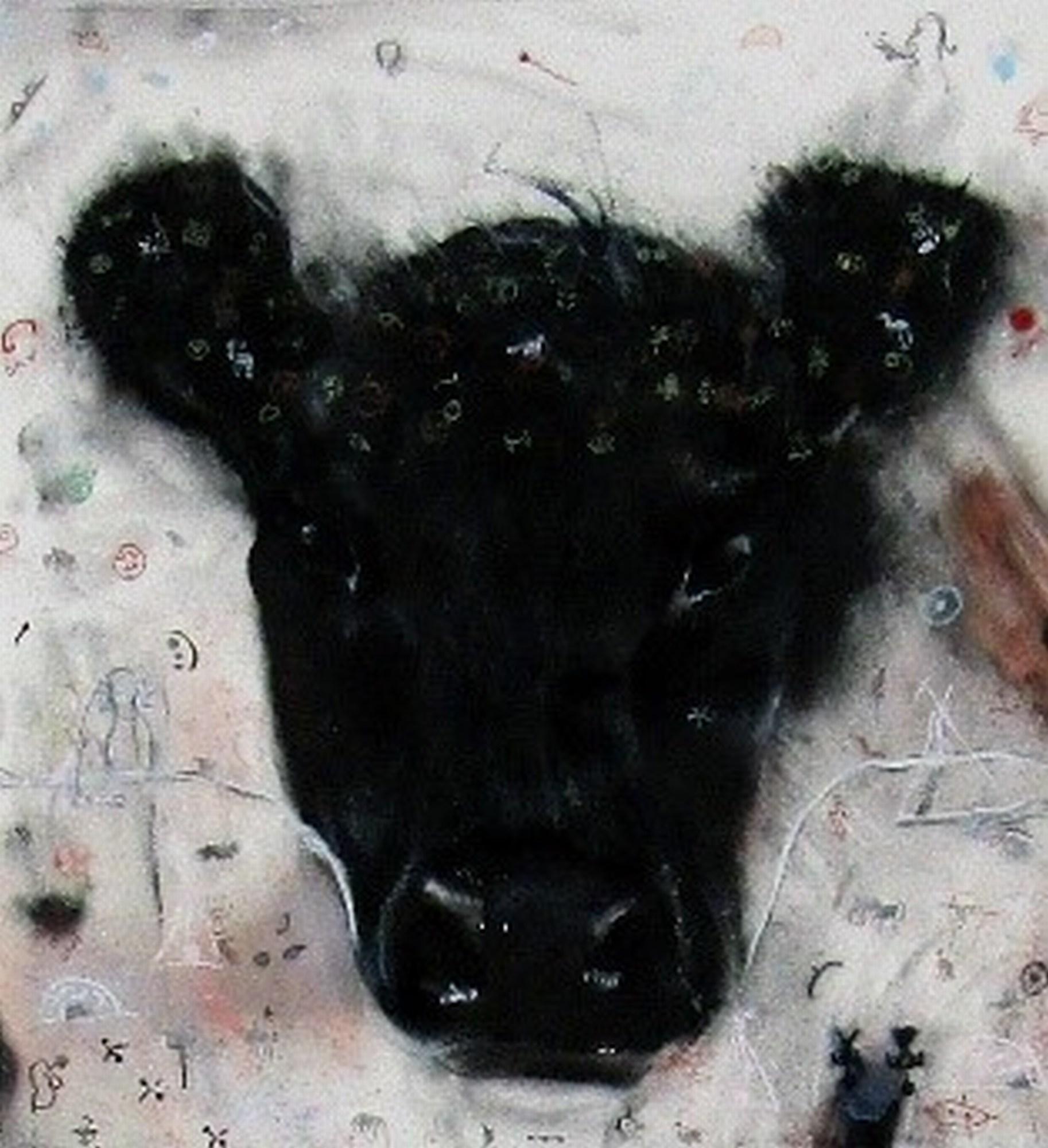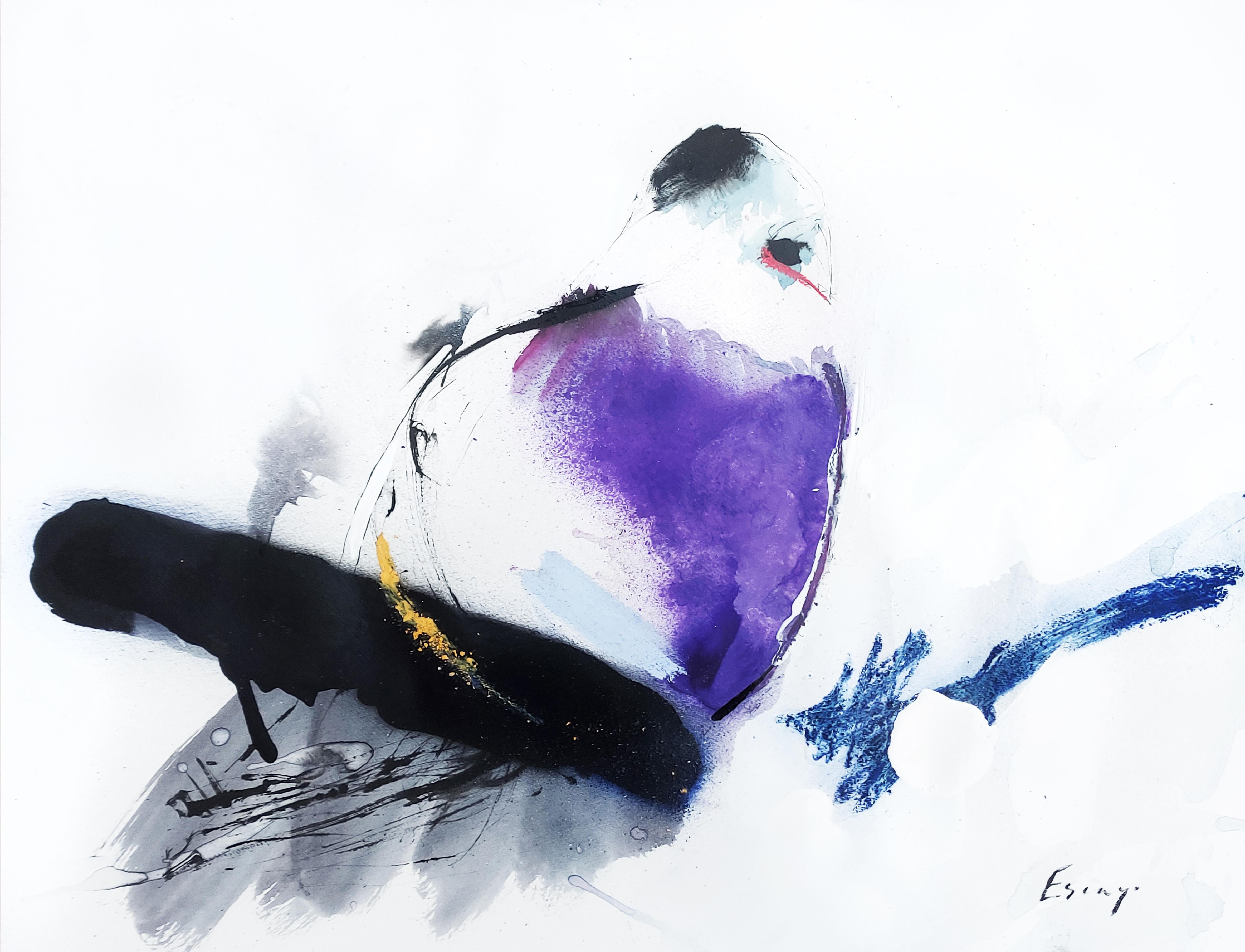Items Similar to Into the Final Furlong. 1965.Race Horses. Equine.Jockeys.Horse Racing.Racetrack.
Want more images or videos?
Request additional images or videos from the seller
1 of 23
John Rattenbury SkeapingInto the Final Furlong. 1965.Race Horses. Equine.Jockeys.Horse Racing.Racetrack.1965
1965
About the Item
John Rattenbury Skeaping.
English ( b.1901 - d.1980 ).
Into the Final Furlong, 1965.
Pastel on Colored Paper. Signed & Dated 1965.
Image size 18.9 inches x 27.6 inches ( 48cm x 70cm ).
Frame size 31.9 inches x 41.1 inches ( 81cm x 104.5cm ).
Available for sale is this original pastel on paper drawing by John Rattenbury Skeaping dated 1965. The artwork is presented and supplied in its original frame that has been painted in chalk paint and its original mount (which is shown in these photographs) and original premium anti-reflective glass with 92% UV protection (ARTGLASS AR92™).
This vintage pastel drawing is in very good condition, commensurate with its age. It wants for nothing and is supplied ready to hang and display.
The painting is signed and dated 1965 lower left.
John Skeaping is regarded as the leading equine sculptor of the twentieth century. He also became a highly regarded racehorse painter in his middle age.
He was born in South Woodford, Essex, England on 9 June 1901. His father was a portrait painter who shared a studio with Cézanne and his mother was a musician. Several other members of his family were also very artistic. He had an unconventional childhood as one of four children, none of whom were sent to school. His father believed in a basic training in the arts and they were therefore taken to exhibitions, concerts, theatre and ballet. For young John, the tandem themes of horses and art emerged and remained with him for the rest of his life.
Aged 13 John Skeaping was already showing an early aptitude, and enrolled at Blackheath School of Art. Then aged 14 he went to Goldsmiths College in the Sculpture School. From there he went to the Central School of Arts & Crafts and then the Royal Academy Schools, where he won the Royal Academy Gold Medal and travelling scholarship. He then taught in Newcastle.
In 1924 he won the Prix de Rome and went to Rome on a three year scholarship. Barbara Hepworth won the second prize and they met in Rome and married in Florence in 1925. They returned to London in 1926 and worked together for a while. Indeed, they put on a joint exhibition in Glasgow and London in 1928 that established them in the forefront of British Sculpture. However, the couple drifted apart artistically and personally and separated in 1931, divorcing two years later.
Skeaping continued modeling and carving, and created several animal pieces for Wedgwood in 1928 of a Sea Lion, Kangaroo, Duiker, Polar Bear, Bison, Tiger, Deer and Antelope groups that are quite stylized and reflect the Art Deco influence of the era. He also did stone carvings of animals during this time.
During the 1930s, Skeaping spent as much time as possible in the countryside with his second wife, whom he married in 1934. They were lent a cottage in Dartmoor, where they stayed for a summer and started to train and race greyhounds.
At the beginning of the Second World War Skeaping served in the Royal Intelligence Corps as an official war artist in Europe before transferring to the SAS in North Africa. However, he began to suffer from nervous stomach trouble and was invalided out just before the end of the war. On his return to civilian life he became disillusioned with London, so went to Devon to live. After a short while though he returned to London and spent a period teaching at the Royal College of Art. He then went to Mexico for a year and a half, living amongst the Indians and learning how to make their traditional pottery.
In 1950 he returned to England and became Professor of Sculpture at the Royal College of Art. He remained there until his retirement in 1959 when he moved to the Camargue in France, partly for health reasons. There he studied the wild horses of the Camargue, and lived for twenty years with his third wife.
Skeaping first exhibited at the Royal Academy in 1922; he was elected an Associate there in 1951 and Academician in 1959.
During the late 1940s and into the 1950s, Skeaping was associated with the famous Ackermann firm who offered sporting and racing art. He produced many paintings and drawings of horses during this time. Most of his equestrian works are from the 1960s and 1970s and his subjects covered racehorses, harness horses, flat racers and steeplechasers. He also did some fine commissioned portraits of famous horses of the day including Triple Crown winner Secretariat, Hyperion, Mill Reef, Brigadier Gerard, Chamossaire, and more. He received many commissions during his life, mainly for his horse sculptures.
Between 1960 and 1969, seven of his one man shows were held at Ackermann’s Gallery, and there were retrospective exhibitions at the same venue in 1979, 1981 and 1984. He wrote and illustrated four books, including his autobiography Drawn from Life, which was published in 1977. He died in London on 5 March 1980.
Today John Skeaping’s sculpture and paintings are in many museum collections, including the Tate, the British Museum, and the Royal Academy in the UK, and others in the USA, Japan, and Australia, as well as in private collections. His bronzes were cast in small editions of 10 or less casts, and are very highly prized.
© Big Sky Fine Art
This pastel on paper artwork depicts two racehorses galloping down a racetrack “into the final furlong”; We can almost hear the course commentator on the public address system. It is executed with the lightest of touch, in a manner which perfectly captures the movement of the moment. Both horses are chestnut, or bay. The jockeys wear traditional jodhpurs, silks and caps, one black and one red. The horse nearest to the viewer is in the lead by a neck and is wearing a sheepskin noseband. He is almost the winner, but we cannot be sure how close the finishing post is away …
- Creator:John Rattenbury Skeaping (English)
- Creation Year:1965
- Dimensions:Height: 31.89 in (81 cm)Width: 41.15 in (104.5 cm)Depth: 1.19 in (3 cm)
- Medium:
- Movement & Style:
- Period:
- Condition:This vintage pastel drawing is in very good condition, commensurate with its age. It wants for nothing and is supplied ready to hang and display.
- Gallery Location:Sutton Poyntz, GB
- Reference Number:1stDibs: LU489313798412
About the Seller
5.0
Gold Seller
These expertly vetted sellers are highly rated and consistently exceed customer expectations.
Established in 2010
1stDibs seller since 2016
110 sales on 1stDibs
Typical response time: 1 hour
- ShippingRetrieving quote...Ships From: Sutton Poyntz, United Kingdom
- Return PolicyA return for this item may be initiated within 14 days of delivery.
More From This SellerView All
- Guardian, Cowboy and Horseman of the Camargue, South of France. Mid-Century.By John Rattenbury SkeapingLocated in Sutton Poyntz, DorsetJohn Rattenbury Skeaping. English ( b.1901 - d.1980 ). Guardian, Cowboy and Horseman of the Camargue,1970. Pastel on Paper. Signed and dated. Paper size 15.2 inches x 20.9 inches (...Category
Mid-20th Century Modern Animal Drawings and Watercolors
MaterialsPaper, Pastel
- The Thief. Original Drawing.Welsh Artist. Magpie.Late 20th Century.Black & WhiteBy Julian RuddockLocated in Sutton Poyntz, DorsetJulian Ruddock. British ( b.1965 ). The Thief. Pastel on Paper. Signed. Image size 29.1 inches x 21.3 inches ( 74cm x 54cm ). Frame size 38.4 inches x 29.9 inches ( 97.5cm x 76cm )....Category
Late 20th Century Expressionist Animal Drawings and Watercolors
MaterialsPaper, Pastel
- Flock of Sheep. Large Pastel.Modern British.West Wales.Welsh. Animal & Farming.Located in Sutton Poyntz, DorsetSusan Pomery Wilks. English ( 20th Century ). Flock of Sheep. Pastel & Charcoal on Paper. Signed. Image size 13.6 inches x 23 inches ( 34.5cm x 58.5cm ). Frame size 21.1 inches x 30...Category
Late 20th Century Abstract Animal Drawings and Watercolors
MaterialsPaper, Charcoal, Pastel
- Dame Elisabeth Frink. Hawk, 1969. Watercolor. A Representation of Destruction.By Elisabeth FrinkLocated in Sutton Poyntz, DorsetDame Elisabeth Frink. English ( b.1930 - d.1993 ). Hawk, 1969. Watercolor. Image size 25.4 inches x 19.5 inches ( 64.5cm x 49.5cm ). Frame size 34.4 inches x 28.1 inches ( 87.5cm x 71.5cm ). Available for sale; this original painting is by Dame Elisabeth Frink and is dated 1969. The painting is presented and supplied in a glazed frame and mount dating from June 1997. This vintage watercolor is in very good condition, commensurate with its age. The watercolor is signed and dated lower right. Previously with Beaux Arts, London and Bath in 1999. Dame Elisabeth Frink was one of Britain’s most important post-war sculptors, an accomplished draughtsman, illustrator and teacher. She was part of the post-war school of expressionist British sculptors dubbed the Geometry of Fear, and enjoyed a highly acclaimed career that was commercially successful, broke boundaries and contributed greatly to bringing wonderful sculpture to public places. She was born on 14 November 1930 in Thurlow, the daughter of a cavalry officer, and brought up in rural Suffolk near to an active airbase. She was brought up a Catholic and educated at the Convent of the Holy Family, Exmouth. She then studied at the Guildford School of Art from 1947-1949 under Willi Soukop and Henry Moore’s assistant, Bernard Meadows, and then at the Chelsea School in London 1949-1953. She taught at Chelsea School of Art 1951-61, St. Martin’s School of Art 1954-62 and was a visiting instructor at the Royal College of Art 1965-1967, after which she lived in France until 1973. Frink first came to the attention of the public in 1951 at an exhibition at the Beaux Arts Gallery, London. In 1952 she represented Britain at the Venice Biennale, being described by Herbert Read as “the most vital, the most brilliant and the most promising of the whole Biennale”. The same year the Tate bought its first work by her, and she began to enjoy commercial success. Thereafter she exhibited regularly and was for 27 years associated with Waddington’s, London. The subjects which Frink was most concerned with were man, dog and horses, with and without riders. Interestingly she seldom sculpted the female form, drawing on archetypes of masculine strength, struggle and aggression. Her work has the recurring themes of the vulnerable and the predatory, in the spirit of an authentic post-war artist. It has been said that she was more concerned with representing mankind that portraits of individuals. The appeal of her work lies in its directness, provoking a frank statement of feeling. The anatomy is often exaggerated or incorrect; the impact growing more out of her interest in the spirit of the subject. Her animals and birds may be drawn from nature but verge on the abstract, conveying raw emotion and character rather than a realistic depiction. Her unique style is characterised by a rough treatment of the surface which embeds each piece with vitality and her personal impression. In her later work even the distinction between human and bird figures becomes blurred. Commentators have noted that the often rugged, brutal and contorted surfaces of her work reflect the destruction and terror of the six-year world-wide conflict that she witnessed as a child. Frink was an active supporter of Amnesty International. In the 1960s and early 1970s Frink produced a notable series of falling figures and winged men. Later, living in France during the Algerian war, she began making heads, blinded by goggles which had a threatening facelessness. Frink produced many notable public commissions, including Wild Boar for Harlow New Town, Blind Beggar and Dog for Bethnal Green, Noble Horse and Rider for Piccadilly, London, a lectern for Coventry Cathedral, Shepherd for Paternoster Square beside St. Paul’s Cathedral and a Walking Madonna for Salisbury Cathedral. In the early 1980s she produced a set of three larger than life figures The Dorset Martyrs which stand on the edge of the old walled town of Dorchester on the site of the old gallows, as a memorial to those who had been executed there ‘for conscience sake’. Frink’s Canterbury Tales was a collection of 19 etchings drawn directly on to copper plates and etched by her. The ‘book’ was issued in three limited editions. Her illustrations have been praised as “amongst the most successful illustrations of the century, encompassing the mood of the text in concise delineations and disarmingly ribald humour”. She illustrated other books with colored lithographs or drawings. Frink was on the Board of Trustees, British Museum from 1976, and was a member of the Royal Fine Art Commission 1976-81. CBR (1969), DBE ((1982), Associate of the Royal Academy (1971), Royal Academy (1977). She was made a Companion of Honour in 1992. She died on 18 April 1993, but not before completing her last commission, a monumental but unusual figure of Christ for the front of the Anglican Cathedral in Liverpool, unveiled a week before her death. For several decades Frink exhibited widely in the UK and abroad. In her later years she lived and worked in Dorset where her home and garden became an arena for her work. In 1985 she had a retrospective at the Royal Academy. She died on 18 April 1993, but not before completing her last commission, a monumental but unusual figure of Christ for the front of the Anglican Cathedral in Liverpool, unveiled a week before her death. There was a memorial show at Yorkshire Sculpture Park, Bretton Hall in 1994. Today Frink is venerated as one of the great twentieth century British sculptors. Her unique work is represented in the Tate Gallery and major public and private collections world-wide. © Big Sky Fine Art This original watercolor on paper painting of a hawk by Dame Elizabeth Frink...Category
Mid-20th Century Modern Animal Paintings
MaterialsPaper, Watercolor
- On the Gallops. 1976.Race Horses. Equine.Jockeys.Horse Racing. Racetrack.By John Rattenbury SkeapingLocated in Sutton Poyntz, DorsetJohn Rattenbury Skeaping. English ( b.1901 - d.1990 ). On the Gallops, 1976. Gouache and Watercolor. Signed & Dated Lower Right. Image size 18.5 inches x 26.8 inches ( 47cm x 68cm )...Category
Mid-20th Century Modern Animal Drawings and Watercolors
MaterialsPaper, Watercolor, Gouache
- Malcolm Edwards. Welsh Sheepdog, Shepherd and Herding Sheep. Mountain Landscape.Located in Sutton Poyntz, DorsetMalcolm Edwards. Welsh ( b.1934 ). Welsh Sheepdog, Shepherd and Sheep Watercolor. Signed. Image size 8.9 inches x 19.7 inches ( 22.5cm x 50cm ). Frame size 16.7 inches x 27.2 inches...Category
Late 20th Century Modern Landscape Drawings and Watercolors
MaterialsPaper, Watercolor
You May Also Like
- rare birds, man with hands raised, colorful pastel humorBy Stephen BassoLocated in Brooklyn, NYPastel on paper, anthropomorphic variety of birdsCategory
2010s American Modern Animal Drawings and Watercolors
MaterialsPaper, Pastel
- Der Fled Maus (Figurative Drawing of Costumed Man with Moon on Teal Paper)By Nicholas Kahn & Richard SelesnickLocated in Hudson, NYFigurative drawing of a costumed man with two moons on handmade teal colored paper "Der Fled Maus", made by Kahn & Selesnick in 2011 mixed media, graphite, and pastel handmade paper 17 x 17 inches in walnut vintage wood frame with 8ply mat 7.5 x 7.5 inches unframed This whimsical mixed media drawing on handmade teal colored paper was made by the creative duo Nicholas Kahn & Richard Selesnick as part of their series "Truppe Fledermaus", wherein the artists celebrate the carnivalesque with a cast of peculiar costumed characters. In this illustration, a cloaked figure stands in front of a door with the moon, in two different phases, appearng in the background. The artists' highly stylized approach adds an almost vintage touch. The drawing is complemented by a simple vintage walnut frame, and a sturdy wire across the back provides for easy hanging. About Truppe Fledermaus: Kahn & Selesnick’s latest project follows a fictitious cabaret troupe – Truppe Fledermaus (Bat Troupe) – who travel the countryside staging absurd and inscrutable performances in abandoned landscapes for an audience of no one. The playful but dire message presented by the troupe is of impending ecological disaster, caused by rising waters and a warming planet, the immediate consequences of which include the extinction of the Bat, a shamanistic figure representing both nature and humanity. In one sense, the entire cabaret troupe can be seen as a direct reflection of the artists themselves, both entities employing farce and black humor to engage utterly serious concerns. About Kahn & Selesnick: Nicholas Kahn and Richard Selesnick...Category
2010s Modern Figurative Drawings and Watercolors
MaterialsMixed Media, Handmade Paper, Pastel, Graphite
- SaltyBy Joseph BroghammerLocated in Kansas City, MODue to the current situation related to the Novel Coronavirus pandemic, our gallery will donate 10% of our commission from this sale to the Kansas City Artists Coalition, which has been supporting local Kansas City Artists for the past 40 years. The Kansas City Artists Coalition (KCAC), is a non-profit, artist-centered, artist-run alternative space, supporting artists at every level in their career through exhibitions, continuing education and artist studios. Artist: Joseph Broghammer Title: “Salty” Materials : Chalk pastel and pencil on Arches Paper Date : 2016 Dimensions : 20 ¼ x 24 in. Omaha based artist Joseph Broghammer is as much of a storyteller as he is an artist. His one-of-a-kind pastel drawings in “Animals” are chronicles of his life. The creatures Broghammer creates are vehicles to uncover the varying characteristics of the artist’s personal identity. Hence, Broghammer’s “Animals” translates as a flowing stream of consciousness. The different birds and livestock staring back at the viewer are ornamented with iconographic symbols – small surprises along the way. These trinkets are keys to understanding the stories Broghammer is sharing. Broghammer began mastering his “dry painting” technique during his B.F.A. in Visual Art at the University of South Dakota. He graduated in 1986 and a year later went on to study his M.F.A. at the University of Wisconsin. In 2009, he studied at Creative Capital in Omaha, Nebraska. As storytellers often do, Broghammer later went on to become an educator himself, teaching at WhyArts? and becoming an Artist Assistant at Vera Mercer...Category
2010s American Modern Paintings
MaterialsPencil, Color Pencil, Chalk, Pastel, Archival Paper
- SRIBy Joseph BroghammerLocated in Kansas City, MODue to the current situation related to the Novel Coronavirus pandemic, our gallery will donate 10% of our commission from this sale to the Kansas City Artists Coalition, which has been supporting local Kansas City Artists for the past 40 years. The Kansas City Artists Coalition (KCAC), is a non-profit, artist-centered, artist-run alternative space, supporting artists at every level in their career through exhibitions, continuing education and artist studios. Artist: Joseph Broghammer Title: “SRI” Materials : Chalk pastel and pencil on Arches Paper Date : 2018 Dimensions : 19 x 21 in. Omaha based artist Joseph Broghammer is as much of a storyteller as he is an artist. His one-of-a-kind pastel drawings in “Animals” are chronicles of his life. The creatures Broghammer creates are vehicles to uncover the varying characteristics of the artist’s personal identity. Hence, Broghammer’s “Animals” translates as a flowing stream of consciousness. The different birds and livestock staring back at the viewer are ornamented with iconographic symbols – small surprises along the way. These trinkets are keys to understanding the stories Broghammer is sharing. Broghammer began mastering his “dry painting” technique during his B.F.A. in Visual Art at the University of South Dakota. He graduated in 1986 and a year later went on to study his M.F.A. at the University of Wisconsin. In 2009, he studied at Creative Capital in Omaha, Nebraska. As storytellers often do, Broghammer later went on to become an educator himself, teaching at WhyArts? and becoming an Artist Assistant at Vera Mercer in Omaha – both of which he still practices at today. It’s apparent that Broghammer’s work has resonated with so many people around the world. Only a few years after his formal education, he began exhibiting his work through various International group shows in Italy, Germany, Holland, Mexico, and even Kansas City. Although Broghammer’s portraits depict downy creatures, his work is very much about the human experience. They are honest and full of life, evoking a sincere exchange between artist and viewer. “Animals” is for the animal lovers, students, teachers, collectors, writers, the young or old, and art historians alike. Dry Painting, Pastel, Drawing, Chalk Pastel, Oil Pastel, Painting, Contemporary Drawing, Contemporary Painting, Animal Drawings, Animal Paintings, colored pencil, pencil, large-scale drawings, portrait, portrait drawing, contemporary art, contemporary artists, Joan Miro, Max Ernst, Leonora Carrington, Vladimir Kush...Category
2010s Modern Drawings and Watercolor Paintings
MaterialsPencil, Color Pencil, Chalk, Pastel, Archival Paper
- Peace Bird VLocated in ARANJUEZ, ESPeace Birds is a series of 5 pieces depicting abstract birds. Rich mix media on paper with vibrant colors and strong pigments , mixing Occidental and orient...Category
2010s Modern Animal Drawings and Watercolors
MaterialsPastel, Ink, Watercolor
- The birds by Gilbert Pauli - Pastel on paper 28x38 cmBy Gilbert PauliLocated in Geneva, CHBorn in 1944 in the canton of Fribourg, Gilbert Pauli currently lives in Geneva, where he devotes himself to painting and sculpture, a passion he developed from his childhood. His fa...Category
1990s Modern Animal Drawings and Watercolors
MaterialsPastel
Recently Viewed
View AllMore Ways To Browse
Japanese Sea Glass
Greyhound Stone Art Deco
Mill Stone Mounted Sculpture
C Stanley
Horse Painting Set
Time Bicycles
Framed Wallpaper Art
Striped Abstract
American Folk Oil Painting
Pair Of Figure Paintings
Egypt Travel
Middle Eastern Artists
Graffiti Art Gold
Oil Painting Planets
Library Draws
John Mood
Brittany Coast
Study Print Set Of Four




